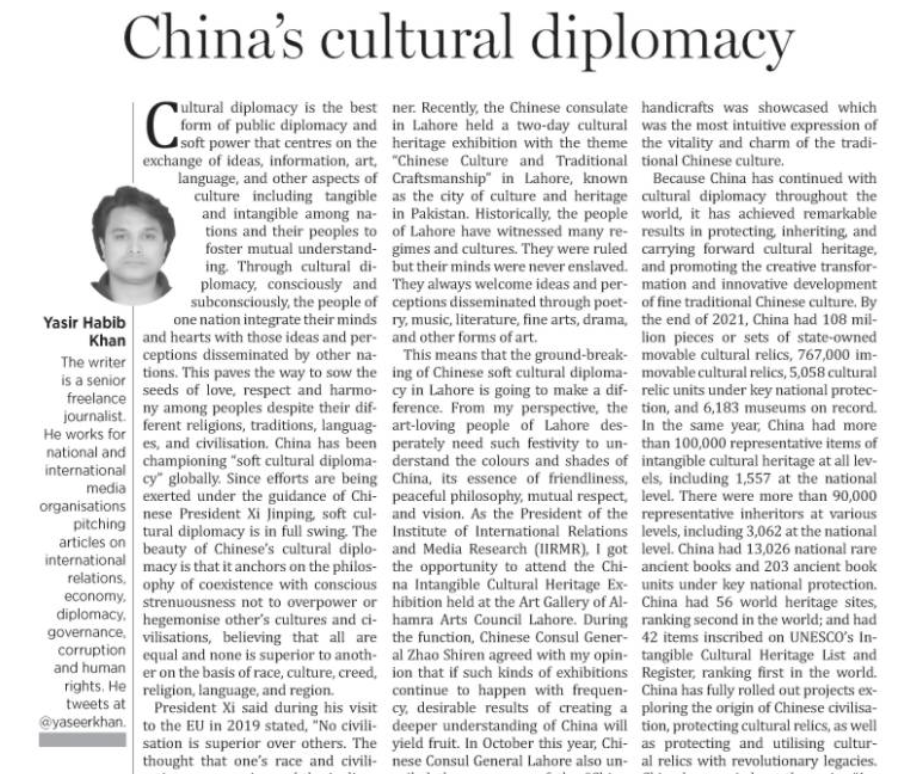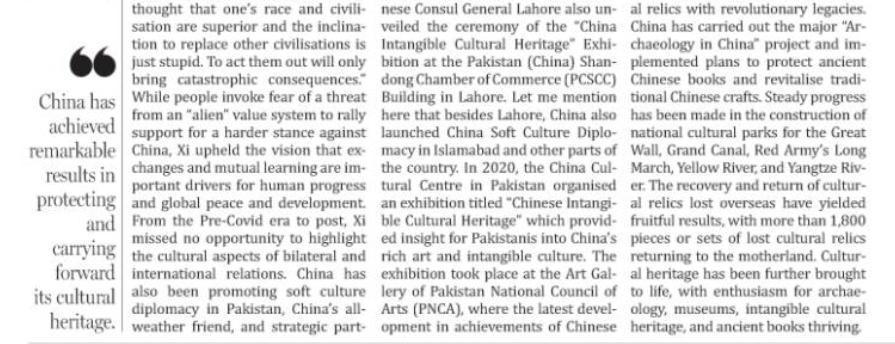2022年12月14日,巴基斯坦国际关系与媒体研究所副所长亚瑟尔发表署名文章“中国的文化外交”。原文如下:
Cultural diplomacy is the best form of public diplomacy and soft power that centres on the exchange of ideas, information, art, language, and other aspects of culture including tangible and intangible among nations and their peoples to foster mutual understanding. Through cultural diplomacy, consciously and subconsciously, the people of one nation integrate their minds and hearts with those ideas and perceptions disseminated by other nations. This paves the way to sow the seeds of love, respect and harmony among peoples despite their different religions, traditions, languages, and civilisation. China has been championing “soft cultural diplomacy” globally. Since efforts are being exerted under the guidance of Chinese President Xi Jinping, soft cultural diplomacy is in full swing. The beauty of Chinese’s cultural diplomacy is that it anchors on the philosophy of coexistence with conscious strenuousness not to overpower or hegemonise other’s cultures and civilisations, believing that all are equal and none is superior to another on the basis of race, culture, creed, religion, language, and region.
President Xi said during his visit to the EU in 2019 stated, “No civilisation is superior over others. The thought that one’s race and civilisation are superior and the inclination to replace other civilisations is just stupid. To act them out will only bring catastrophic consequences.” While people invoke fear of a threat from an “alien” value system to rally support for a harder stance against China, Xi upheld the vision that exchanges and mutual learning are important drivers for human progress and global peace and development. From the Pre-Covid era to post, Xi missed no opportunity to highlight the cultural aspects of bilateral and international relations. China has also been promoting soft culture diplomacy in Pakistan, China’s all-weather friend, and strategic partner. Recently, the Chinese consulate in Lahore held a two-day cultural heritage exhibition with the theme “Chinese Culture &Traditional Craftsmanship” in Lahore, known as the city of culture and heritage in Pakistan. Historically, the people of Lahore have witnessed many regimes and cultures. They were ruled but their minds were never enslaved. They always welcome ideas and perceptions disseminated through poetry, music, literature, fine arts, drama, and other forms of art.
This means that the ground-breaking of Chinese soft cultural diplomacy in Lahore is going to make a difference. From my perspective, the art-loving people of Lahore desperately need such festivity to understand the colours and shades of China, its essence of friendliness, peaceful philosophy, mutual respect, and vision. As the President of the Institute of International Relations and Media Research (IIRMR), I got the opportunity to attend the China Intangible Cultural Heritage Exhibition held at the Art Gallery of Alhamra Arts Council Lahore. During the function, Chinese Consul General Zhao Shiren agreed with my opinion that if such kinds of exhibitions continue to happen with frequency, desirable results of creating a deeper understanding of China will yield fruit. In October this year, Chinese Consul General Lahore also unveiled the ceremony of the “China Intangible Cultural Heritage” Exhibition at the Pakistan (China) Shandong Chamber of Commerce (PCSCC) Building in Lahore. Let me mention here that besides Lahore, China also launched China Soft Culture Diplomacy in Islamabad and other parts of the country. In 2020, the China Cultural Centre in Pakistan organised an exhibition titled “Chinese Intangible Cultural Heritage” which provided insight for Pakistanis into China’s rich art and intangible culture. The exhibition took place at the Art Gallery of Pakistan National Council of Arts (PNCA), where the latest development in achievements of Chinese handicrafts was showcased which was the most intuitive expression of the vitality and charm of the traditional Chinese culture.
Because China has continued with cultural diplomacy throughout the world, it has achieved remarkable results in protecting, inheriting, and carrying forward cultural heritage, and promoting the creative transformation and innovative development of fine traditional Chinese culture. By the end of 2021, China had 108 million pieces or sets of state-owned movable cultural relics, 767,000 immovable cultural relics, 5,058 cultural relic units under key national protection, and 6,183 museums on record. In the same year, China had more than 100,000 representative items of intangible cultural heritage at all levels, including 1,557 at the national level. There were more than 90,000 representative inheritors at various levels, including 3,062 at the national level. China had 13,026 national rare ancient books and 203 ancient book units under key national protection. China had 56 world heritage sites, ranking second in the world; and had 42 items inscribed on UNESCO’s Intangible Cultural Heritage List and Register, ranking first in the world. China has fully rolled out projects exploring the origin of Chinese civilisation, protecting cultural relics, as well as protecting and utilising cultural relics with revolutionary legacies. China has carried out the major “Archaeology in China” project and implemented plans to protect ancient Chinese books and revitalise traditional Chinese crafts. Steady progress has been made in the construction of national cultural parks for the Great Wall, Grand Canal, Red Army’s Long March, Yellow River, and Yangtze River. The recovery and return of cultural relics lost overseas have yielded fruitful results, with more than 1,800 pieces or sets of lost cultural relics returning to the motherland. Cultural heritage has been further brought to life, with enthusiasm for archaeology, museums, intangible cultural heritage, and ancient books thriving.


